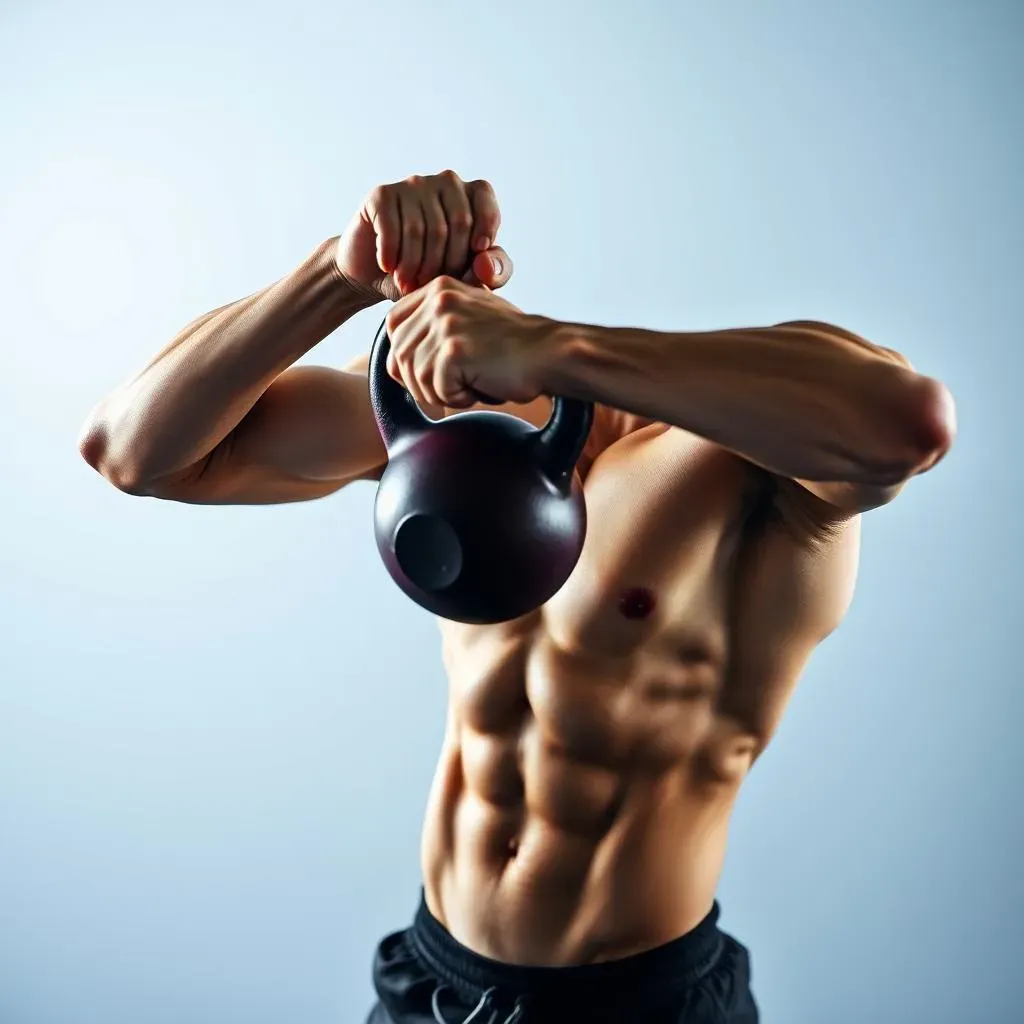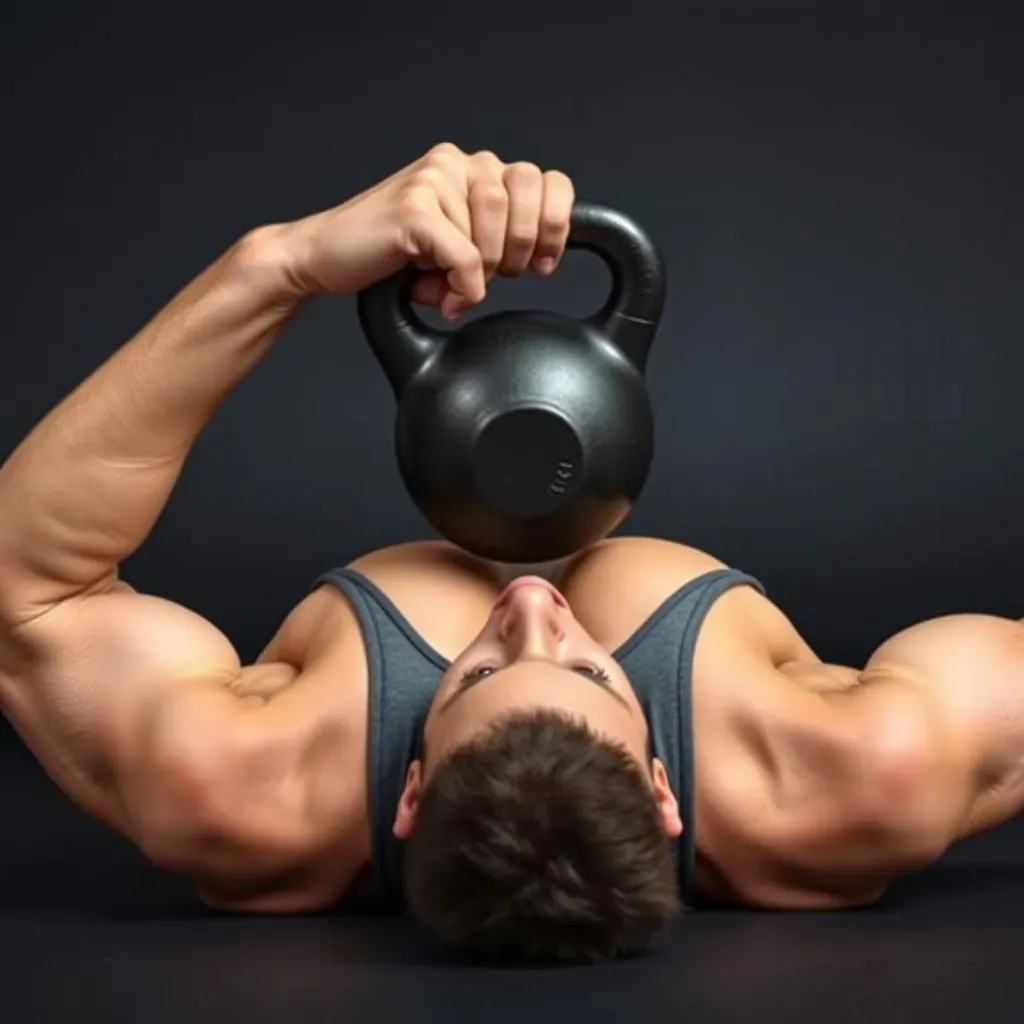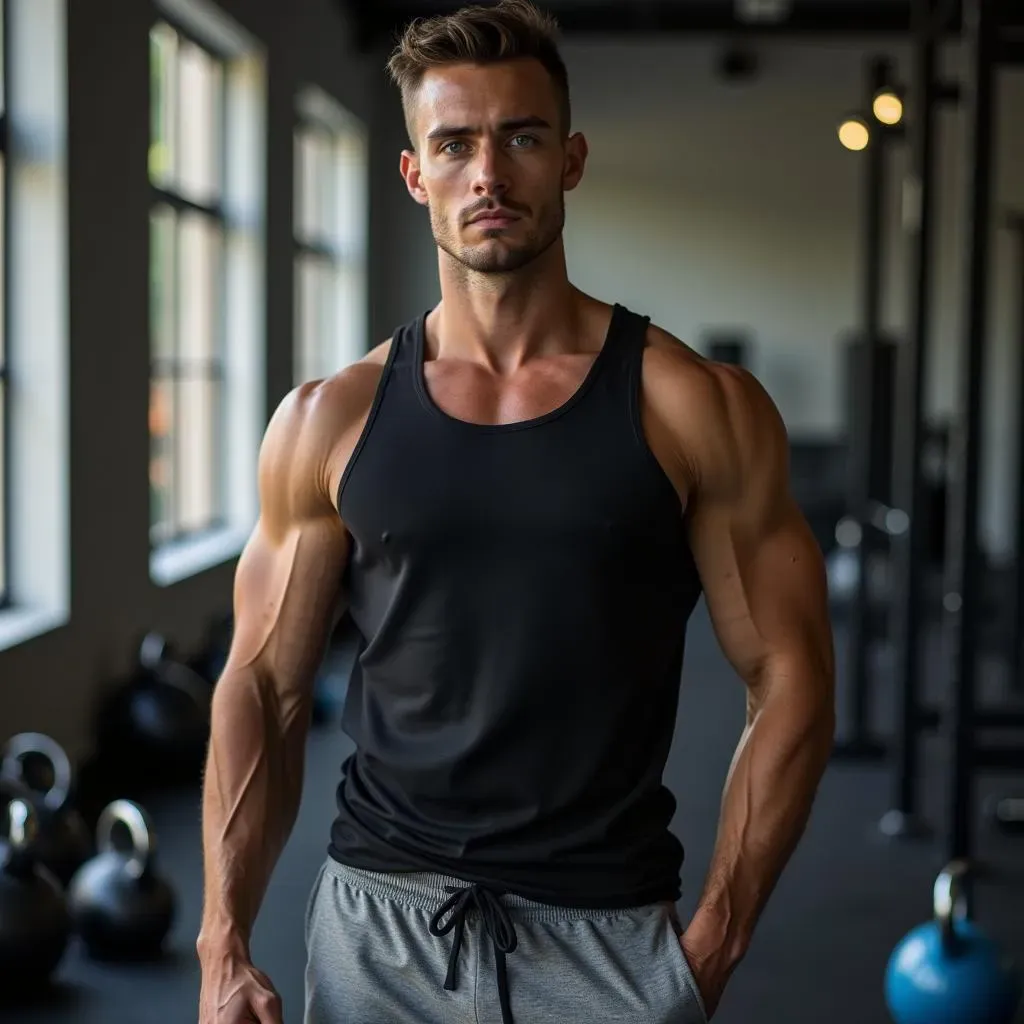Table of Contents
Ready to ditch the boring bench press and sculpt a chest that screams power? If you're nodding, you're in the right place. We're diving into the world of the kettlebell chest workout onnit style, and trust me, it's a game-changer. Forget those clunky machines; kettlebells offer a dynamic, full-body approach that’ll not only build your chest but also ignite your core and improve overall strength. This isn't just about pushing weight; it's about mastering movement and unlocking your body's potential. We'll explore why kettlebells are awesome for chest work, look at some killer exercises you can steal from Onnit's playbook, guide you on building your own workout, and give you the inside scoop on getting the most out of every swing and press. So, let’s grab those kettlebells and get after it! Prepare to feel the burn and see real results.
Why Kettlebells Are Great for Chest Workouts

Why Kettlebells Are Great for Chest Workouts
Beyond the Bench: The Kettlebell Advantage
Let's be real, the classic barbell bench press gets all the chest-building glory, but kettlebells? They bring a whole different kind of magic to the table. Unlike barbells, kettlebells force you to stabilize the weight, which means your chest muscles aren't just pushing; they're also working overtime to keep everything in check. This creates a more functional, real-world kind of strength. Plus, you're not stuck in one plane of motion; kettlebells let you move freely, working your chest from different angles, which is key to developing a well-rounded, powerful chest.
Think of it like this: a barbell is like a train on tracks, going straight forward. A kettlebell is like a nimble race car, able to weave and turn. It is a dynamic approach to chest training, not just a linear push.
Unlocking Functional Strength with Kettlebells
One of the biggest perks of kettlebell training is how it translates to everyday life. When you're doing kettlebell chest exercises, you're not just building muscle; you're also improving your coordination, balance, and core strength. It's a full-body workout disguised as a chest day. Kettlebells force your muscles to work together, building a kind of strength that's actually useful outside the gym. This is because of the offset weight of the kettlebell, which forces your body to engage more muscles to maintain stability.
For example, a kettlebell press isn't just about pushing the weight up; it's about controlling the bell, engaging your core to keep your body stable, and using your chest to drive the movement. This makes kettlebell training far more practical than isolating your chest on a machine.
Benefit | Explanation |
|---|---|
Stability | Forces your muscles to work harder to control the weight. |
Full-Body Engagement | Engages your core, shoulders, and back, not just your chest. |
Functional Strength | Builds strength that translates to real-world movements. |
Versatility | Allows for a variety of exercises and angles to target the chest. |
Joint-Friendly Chest Training
Let's face it, heavy bench presses can be tough on your joints, especially if you've had any past shoulder issues. Kettlebells offer a more joint-friendly alternative because the movements are often more natural and fluid, reducing the stress on your shoulders and elbows. The offset weight of the kettlebell allows your joints to move in a more natural range of motion. This can be a game-changer if you struggle with joint pain or discomfort, allowing you to train your chest without the risk of injury. I've seen people who couldn't touch a barbell without pain find a new love for chest workouts with kettlebells.
Key Kettlebell Chest Exercises from Onnit

Key Kettlebell Chest Exercises from Onnit
Kettlebell Floor Press: Your Chest's New Best Friend
Alright, let's talk about the Kettlebell Floor Press, a real gem from the Onnit playbook. It's like a bench press, but way more grounded. You're lying on the floor, which limits your range of motion, but that's the point. It forces your chest to work harder and also gets your triceps and shoulders in on the action. It's fantastic for building raw strength, and because you're on the floor, it's also easier on your lower back. I love this exercise because you really feel the muscles working, and it’s a great alternative if you don't have a bench.
Here’s the deal: you lie down, hold a kettlebell in one hand, and press it up towards the ceiling. It's simple, but it's effective. The key is to keep your core tight and control the weight. Don’t just fling it up there; feel the burn. Onnit often emphasizes controlled movements for maximum muscle engagement, and this exercise is a prime example of that philosophy.
Kettlebell Chest Supported Row: Pull and Push
Now, let’s switch gears a bit, because your chest isn’t just about pushing; it’s about pulling too. The Kettlebell Chest Supported Row is where we bring in that back and chest connection. You'll need a bench or something similar for support. This move not only strengthens your chest but also works your back muscles, which is crucial for balanced upper body strength. Think of this as the perfect pairing with the floor press. You're not just building a chest; you're building a balanced physique.
You’ll be leaning on the bench, holding the kettlebells, and pulling them towards your chest. It's like a row, but with the support of the bench, which allows you to really focus on the chest and back muscles. When you get this right, you’ll feel it all the way from your lats to your pecs, which is pretty awesome. This exercise is a great example of the integrated approach Onnit takes to training. It's not just about isolating muscles; it's about working them together.
Exercise | Muscles Targeted | Benefits |
|---|---|---|
Kettlebell Floor Press | Chest, Triceps, Shoulders | Builds raw strength, lower back friendly |
Kettlebell Chest Supported Row | Chest, Back, Lats | Balanced upper body strength, targets the back |
Kettlebell Pullover: The Dynamic Stretch
let's talk about the Kettlebell Pullover. This one is a bit different; it's not just a strength move, it's also a fantastic stretch for your chest and lats. It’s like giving your chest a big, satisfying yawn. You’re lying on your back, holding the kettlebell, and slowly lowering it behind your head. This stretches the chest muscles and then engages them as you pull the kettlebell back up. This move is great for improving flexibility and muscle activation.
The key is to control the movement and focus on the stretch in your chest and lats. Don't just let the weight drop; feel the muscles lengthening and contracting. It's like a dance between strength and flexibility. I’ve found that adding this to my routine has really improved my posture and made my chest feel more open. Onnit often talks about mobility and movement quality, and this exercise fits perfectly into that philosophy. It's not just about lifting weights; it's about moving well.
Crafting Your Own Kettlebell Chest Workout Onnit Style

Crafting Your Own Kettlebell Chest Workout Onnit Style
Selecting Your Exercises
Alright, so you're ready to piece together your own kettlebell chest workout onnit style? It's not about just throwing random exercises together; it's about picking movements that hit your chest from all angles and give you a balanced approach. Start with the basics. The Kettlebell Floor Press should be your go-to for building raw power. Then, bring in the Chest Supported Row to balance out the push with a good pull, hitting the back muscles too. Don't forget the Pullover, it’s great for stretching and activating your chest muscles. Choose 2-3 exercises to begin with, and perfect these before adding more. Remember, it's about quality over quantity.
Think of it like building a house: you need a solid foundation before you can add the fancy stuff. These three exercises are a great starting point, but feel free to add others as you get more comfortable. Onnit's philosophy isn't about sticking to one thing; it’s about experimenting and finding what works best for your body.
Structuring Your Workout: Sets, Reps, and Rest
Now that you've got your exercises picked out, let's talk about how to structure your workout. Don't just go in and start flinging kettlebells around. You need a plan. Start with 3 sets of 8-12 reps for each exercise. This range will help you build muscle without overdoing it, especially if you're new to kettlebell training. Rest for about 60-90 seconds between sets. This will give your muscles enough time to recover before you hit them again. Remember, consistency is key, so aim for 2-3 chest workouts per week, but make sure you give your muscles time to recover.
I find that a good workout should leave you feeling challenged but not completely drained. If you're struggling to maintain good form, it’s time to reduce the weight or the reps. It's better to do a few quality reps than a bunch of sloppy ones. Onnit always stresses the importance of proper form, and it's something you should keep at the forefront of your mind when you're working out. Remember, this isn't a race; it's about building strength and endurance over time.
Workout Element | Recommendation |
|---|---|
Exercises | 2-3 Chest Exercises (Floor Press, Chest Supported Row, Pullover) |
Sets | 3 Sets |
Reps | 8-12 Reps Per Set |
Rest | 60-90 Seconds Between Sets |
Frequency | 2-3 Times Per Week |
Progressive Overload: Keeping the Gains Coming
so you've been doing the same workout for a few weeks now, and you're starting to feel like it's getting easy? That's a good thing! It means you're getting stronger, but it also means it's time to crank it up a notch. This is where progressive overload comes in. It's basically about gradually increasing the demands on your muscles to keep them growing. You can do this by adding more weight, increasing the reps or sets, or reducing the rest time. The idea is to always be pushing yourself just a bit further.
For example, if you were doing 3 sets of 10 reps with a 16kg kettlebell, try moving up to 3 sets of 12 reps, or increase the weight to 20kg. It's all about making small, incremental changes over time. Onnit's approach to training is all about continuous improvement, and progressive overload is the best way to ensure you’re making progress. It’s not about going from zero to hero overnight. It’s about consistently pushing your limits and challenging yourself to be better than you were yesterday.
Remember, it's not about how much you can lift today; it's about how much you can lift next month. Be patient and trust the process. Your chest will thank you for it.
Tips for Maximizing Your Kettlebell Chest Workout Onnit

Tips for Maximizing Your Kettlebell Chest Workout Onnit
Mastering the Mind-Muscle Connection
so you're swinging those kettlebells, but are you really feeling your chest working? It's not just about going through the motions; it's about creating that mind-muscle connection. This means focusing on the muscles you're trying to target, really visualizing them contracting and lengthening with each rep. It's like having a conversation with your chest, making sure it's engaged and doing its job. This might sound a bit woo-woo, but trust me, it makes a huge difference. Think of it as directing all that effort right where you want it, instead of just letting other muscles take over. Onnit often talks about intent and focus, and this is where that really comes into play.
For example, when you're doing the kettlebell floor press, focus on squeezing your chest muscles as you push the weight up. Don't just think about lifting the weight; think about driving it up with your pecs. You should feel the muscles working hard. It's not just about lifting weight, it's about lifting it with purpose. If you can't feel the chest working, you're probably not engaging it properly, so adjust your form or reduce the weight until you can.
The Power of Controlled Movements
Alright, let's talk about speed. Or rather, let's not talk about speed. When it comes to kettlebell chest workouts, slow and controlled movements are your best friend. Forget about rushing through your reps. You're not trying to set a speed record; you're trying to build a powerful chest. The key is to focus on the eccentric (lowering) phase of each exercise. That's when your muscles are lengthening under tension, which is crucial for muscle growth. By controlling the weight on the way down, you're maximizing the time your muscles are under tension, and that's where the magic happens. Onnit stresses the importance of controlled movements and this is a prime example of why. It's about quality over quantity, always.
For example, when doing the kettlebell pullover, don't just let the weight drop behind your head. Lower it slowly and deliberately, feeling the stretch in your chest and lats. Then, pull it back up with control, engaging your chest muscles. The slower you go, the more you'll feel your muscles working. This approach also reduces the risk of injury, making your workouts more effective and safer.
Tip | Explanation |
|---|---|
Mind-Muscle Connection | Focus on the chest muscles during each rep. |
Controlled Movements | Slow down your reps, especially the eccentric phase. |
Fueling Your Body for Success
so you're crushing your kettlebell workouts, but are you fueling your body correctly? It's not just about what you do in the gym; it's about what you do in the kitchen too. You need to make sure you're getting enough protein to help your muscles recover and grow. Think of protein as the building blocks for your muscles. You also need to make sure you're eating a balanced diet with plenty of fruits, vegetables, and healthy fats. This will give you the energy you need to power through your workouts and recover properly. Onnit emphasizes the importance of nutrition, and it's something you should pay attention to if you want to maximize your results. Remember, you can't build a house on a weak foundation.
For example, try to eat a protein-rich meal or snack within an hour after your workout to help your muscles recover. A protein shake, some chicken, or some eggs are all great options. Don't forget about carbohydrates either, they're your body's main source of fuel. The right diet will not only help you build a stronger chest, but it will also improve your overall health and well-being. Remember, it's not just about lifting weights; it's about living a healthy lifestyle.
Wrapping Up Your Kettlebell Chest Journey
So, there you have it, your guide to unleashing a powerful chest using kettlebells, the Onnit way. Remember, it's not just about the exercises, it's about the consistent effort and understanding the how and why behind each movement. From mastering the basics to crafting your own routines, you're now equipped to take your chest workouts to the next level. Don't be afraid to experiment, listen to your body, and most importantly, enjoy the process. The kettlebell chest workout onnit style is a journey, and every rep is a step towards a stronger, more resilient you. Now, go swing, press, and conquer!